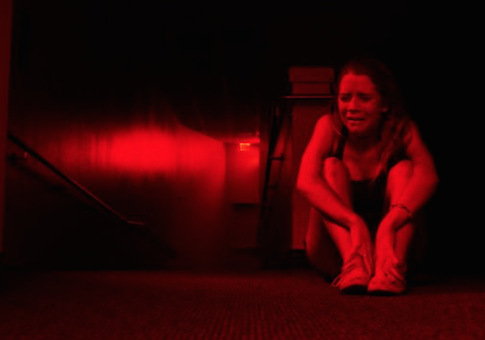I wouldn’t want to definitively say The Gallows is the nadir of the found footage genre—never underestimate the film industry’s ability to lower the bar—but I have to hope we’re nearing rock bottom.
The Gallows relates the misadventures of the creatively named Reese Houser (Reese Mishler), Pfeifer Ross (Pfeifer Brown), Ryan Shoos (Ryan Shoos, seriously), and Cassidy Spilker (Cassidy Gifford). Before we get to them, however, we open with a brief introduction: A VHS from 1993 shows the original production of the eponymous play, which concluded with a student accidentally being hanged from the neck until he was dead.
Flash forward 20 years to our foursome. Ryan, who apparently films his whole life, thus providing the footage to be found by police after the fact, convinces his friend and former football teammate Reese, the lead in the eponymous school play, to destroy the set the evening before opening night. When Cassidy, Ryan’s cheerleader girlfriend, catches wind of the plot, she demands to come along. The trio stumbles upon Pfeifer—the school’s resident drama queen, the play’s female lead, and Reese’s secret crush—while trying to tear down the set.
Needless to say, everything goes to hell pretty quickly. Charlie, the kid who died 20 years earlier, haunts the auditorium and picks the crew off one by one—after magically shutting down their cell service and showing them a spooky video of what went down before.
It makes sense that Hollywood loves the found footage gimmick made famous by The Blair Witch Project and Paranormal Activity: It’s incredibly cheap to shoot on handheld cameras while not worrying at all about lighting or setups, and audiences are willing to excuse the amateurish performances as "naturalistic" rather than "bad." But it so rarely makes sense in terms of the plot that one can’t help but be annoyed.
The filmmakers certainly don’t care. We don’t even get a line telling us that Ryan is, I dunno, filming a documentary about the resurrection of the play 20 years after the death of Charlie. There’s literally no reason whatsoever for Ryan to be walking around with a camera filming his daily activities and his nocturnal crime spree. He’s just shooting because we need a perspective.
Hollywood’s shoddy treatment of POV has gotten out of hand in recent years. We’re nearing the point where "perspective," as a concept, is totally arbitrary. I suspect that The Office was a remarkably bad influence in this regard, although the sitcom’s reliance on interviews with staff members worked for that program under the flimsy pretense that someone was shooting a documentary for a bunch of years about a paper supply company.
Modern Family, meanwhile, has adopted the same tic without even bothering to forge a pretense. It’s not just the sit-down interviews with the Dunphy family that make no sense—it’s the fourth-wall-breaking stares at the camera, the frustrated sighs and eye rolls. These are funny moments, granted. But they’re logically questionable and visually incoherent, violating any sense of the moving image as a constructed space.
The Gallows takes this trend to its absurd conclusion. In one scene, Cassidy is sitting by herself in a dark room. Earlier in the film she had been grabbed by an unseen force and yanked off the ground, as if by a noose. The scare left a bruise on her neck—a wound that is getting worse. However, we can’t see it getting worse. So she takes the camera, pulls it close, and shoots a shot of her neck. This is done for the viewers’ benefit, so we can see the newly suppurating boils. But it makes no sense in the world of the film. She can’t see the wound. She doesn’t, say, stop and rewind and look at it. She just shoots the image.
If you make it through the blessedly short 81-minute running time, you’ll be treated to a decent if biologically questionable twist as well as an incredibly ridiculous and unnecessary coda. There are more than a few jump scares, and the setting is quite spooky; if you’re into this sort of thing, you’ll enjoy yourself just fine.
But why are you into this sort of thing?
